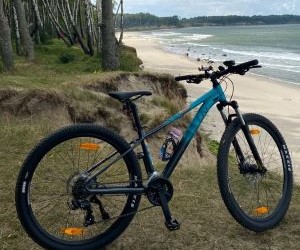Learn how to choose gravel bike geometry by comparing stability, comfort, and performance factors that match your riding style and terrain needs.
WHAT CYCLING GEAR IS BEST FOR WINTER RIDES?
Winter cycling doesn’t have to mean indoor trainers and canceled rides. With the right gear, you can ride through the cold season safely and comfortably—no matter how low the temperature drops. This comprehensive guide breaks down the best winter cycling clothing and accessories, including base layers, insulated jackets, gloves, tires, and more. Whether you're commuting, training, or just riding for fun, the right gear can transform winter into your most productive season on two wheels.

Layering up for warmth and performance
Mastering the three-layer rule
The foundation of winter cycling comfort is effective layering. Start with a moisture-wicking base layer that keeps sweat off your skin. Merino wool or synthetic materials work best here. The second layer—your mid-layer—should provide insulation without bulk. Fleece-lined jerseys or thermal long sleeves are ideal. Finally, your outer layer must block wind and water while still being breathable, like a softshell or hardshell cycling jacket.
The key is adaptability. You want gear that you can unzip or remove if you overheat mid-ride. Look for garments with venting options, extended cuffs, and drop tails to protect against wind chill and wheel spray. Prioritize functionality over fashion; warmth and mobility win every time.
Best fabrics and fit for winter riding
Not all materials are created equal in cold weather. Avoid cotton, which traps moisture and accelerates chilling. Instead, choose high-performance fabrics like Gore-Tex, Windstopper, or Polartec Power Stretch. These offer thermal regulation and breathability while shielding you from the elements.
Base Layer: Merino wool or synthetic blend
Mid Layer: Thermal jersey or fleece-lined top
Outer Layer: Waterproof/windproof jacket with vents
Fit Tip: Snug but flexible to avoid wind drag
Extra: Neck gaiters and thermal arm warmers
Effective layering lets you regulate temperature as you ride and prevents sweat from turning into icy discomfort. It's the cornerstone of every great winter cycling setup.
Protecting your extremities
Cold hands and feet can end your ride
Your core might stay warm, but if your hands and feet freeze, the ride's over. Fingers and toes are the first to suffer from reduced circulation in cold weather. That’s why insulated, water-resistant gloves and thermal shoe covers are critical. Go for lobster-style gloves if you need extra warmth without losing dexterity.
Winter-specific cycling shoes, combined with neoprene overshoes, can make a big difference on freezing days. Add wool socks and avoid layering too tightly, which restricts blood flow. Chemical toe warmers can be a game-changer on sub-zero days.
Head and eye protection
A thermal skull cap or under-helmet beanie helps retain heat without compromising helmet safety. Windproof headbands can also protect your ears without overheating your head. For your eyes, use clear or yellow-lens glasses to shield from wind, debris, and low-light glare.
Gloves: Insulated, windproof, with touchscreen fingers
Footwear: Winter shoes or waterproof overshoes
Socks: Merino wool, not cotton
Headgear: Skull caps, balaclavas, ear warmers
Eyewear: Anti-fog lenses with UV protection
Protecting your extremities ensures control, comfort, and endurance. These small gear upgrades often have the biggest impact on winter ride quality.
Gear, tires, and visibility tips
Bike adjustments for winter conditions
Your bike needs winterization too. Swap summer tires for wider, grippier ones—consider winter-specific or all-weather tires with puncture resistance. Lower tire pressure slightly for better traction on wet or icy surfaces. Clean and lube your chain more often in winter since salt and grit accelerate wear.
Install fenders to stay dry and protect your drivetrain. Also, consider a winter-specific wheelset if you ride frequently—aluminum rims with disc brakes offer better stopping power in wet or freezing conditions.
Staying safe and seen
Winter rides often mean riding in low light. Equip your bike with powerful front and rear lights—even during daytime rides. Wear reflective gear, and opt for jackets and legwear with built-in visibility panels. Safety is about more than speed; it’s about being seen by cars, pedestrians, and other cyclists.
Tires: Wider, with deeper tread for grip
Lights: 200+ lumens front, flashing rear
Fenders: Full-length for max splash protection
Lube: Wet lube for longer protection
Visibility: Reflective strips, helmet lights, bright colors
Your winter gear isn’t just about staying warm—it’s about staying safe, visible, and prepared for anything the road or trail throws at you. Invest wisely, ride confidently.
YOU MAY ALSO BE INTERESTED






